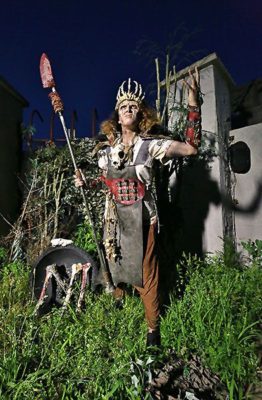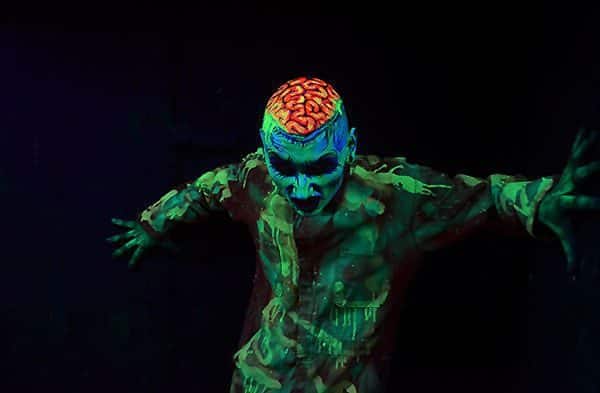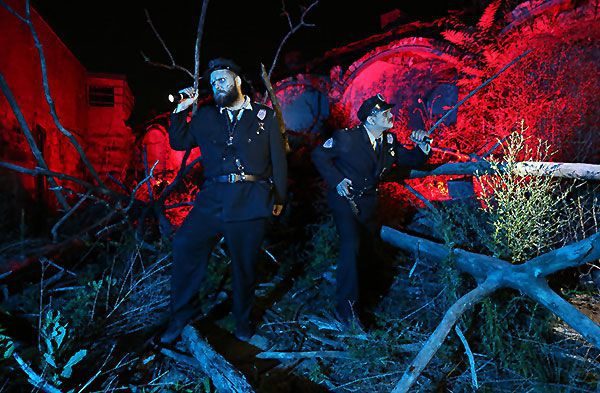By Dr. Margee Kerr, Edited by Staff
What follows is a summary of Dr. Margee Kerr’s keynote given at the 2017 Haunted Attraction Symposium, the theme for which was ‘Innovation in Interactivity.’ This symposium, sponsored by the Haunted Attraction Network and Gantom Lighting & Controls, featured six keynote talks, each themed on a different aspect of interactivity.
Allow this article and the other five in this issue of The Haunt Journal to inspire your team toward new levels of interactivity.
Dr. Kerr’s presentation focused on training actors in the science of immersive interactivity—and, especially, how we define and create that interactivity. The talk began: “When we educate actors on why they’re doing what they’re doing, on the science of senses like touch and sound, on agency and prediction, we empower them to improvise in ways that are creative, personalized, and—most importantly—keep themselves and guests safe.”

Why is Actor Education Important?
“Why actor education is important is one of the main reasons we’re all here today. There’s no real cultural script or framework for immersive, interactive theater—and that’s exciting,” stated Dr. Kerr. “We get to define it ourselves. But this puts a lot of responsibility on the designers, creators, and actors to make sure people know what they’re getting into and what they’re signing up for. I see interactivity as bringing groups of people together—the actor, the designer, and the guest—and creating something new, something that didn’t exist before and won’t exist after,” she said.
Defining the Goals of the Experience
“As humans, we’re constantly mediating and moderating our emotional experiences. Our engagement and degree of interaction have a direct impact on how we feel. Therefore, interactivity in entertainment means mediating emotions and having an intention to do that. We have to decide what we want to create for our guests and the emotional journey we want our guests to have. The experience starts with an understanding of what that vision is, what the story is, and being able to communicate that to actors and guests,” explained Dr. Kerr. “We have to understand what the goals of our experience are as a whole and in each specific scene. What is it we want this person or this group to experience? We have to think about what we want professionally, what we want creatively, and what our boundaries are.”
Dr. Kerr continued, “Once you know what the goal is for the experience and the specific scene, interactivity is the way to achieve it. The next step is to explain this to your actors. You want them to buy in and be a believer, or, at the very least, understand what the motivation is and what the emotional experience is that you’re going for because they’re the ones creating that experience,” she stated.
The Key is Immersive Interactivity
“The goal is to create an experience that feels like a different world. You get to decide what that world looks like, but the goal is to incite intense emotional responses. You want to create something that’s unique and personalized, and that’s going to go a long way in promoting sharing, return visits, and conversation [about your attraction]. Before you even start hiring actors, you need to know what your world is going to look like and what the journey will be,” Dr. Kerr advised.
“Because our expectations very literally define our experience, we compare every experience to what our expectations were going in. This is challenging for immersive interactivity because we don’t have a model to compare. The field is new territory- you want to be the one setting those expectations. That means you have to figure out how to communicate the experience to the actors and the guests, because, again, this is all interactive.”
Dr. Kerr emphasized that educating actors about what to expect is critical. “When it comes to communicating the experience to the actors, you need to let them know not only what their boundaries are but what people might say to them that could potentially upset them. This is true for guests as well. When I talk about communicating the experience, this means helping guests set their frame of reference for the experience. You’re letting them know how to prepare and how to set their expectations. So, be explicit. Say, ‘You’re going to crawl, you’re going to walk, you’re going to be restrained, you’re going to be touched, or whatever.’ This isn’t giving anything away. It’s allowing the guest to make an informed decision. Agency and trust are critical, and this is where that starts—with guests making an informed choice.”

Immersion Results from a Sense of Agency and Trust—in Actors and Guests
Agency, stated Dr. Kerr, starts with instilling trust. “Actors have to trust you, and guests must trust the actors. Interactive experiences are a social contract among the creators, the actors, and the designers. There has to be a sense of mutual trust,” she said.
“What you’re essentially asking guests to do when they come into your experience is to be emotionally vulnerable. You’re asking them to suspend their disbelief, to lean into the experience, to open themselves up to this world you’ve created, to this journey you’re hoping they’ll go on. It may seem counter-intuitive, but that starts with ensuring, communicating, and following through with a sense of safety. Our brain processes experiences differently when we have a sense of trust and agency than when we’re truly in an ‘Oh my god, I’m legitimately going to die’ situation. You need to create a sense of safety so people can have the experience,” stated Dr. Kerr.
“Agency is a feeling. It’s the sense you’re in control of your experience and are an active participant in your environment. It’s essential that actors feel this. Actors should never feel like they’re being directed to do something they don’t want to do, that they haven’t agreed to do. It’s important for actors to understand this as a principle, so they respect the boundaries in scenes with the guests,” she said.
“Agency starts with people making an informed decision. When they do that, they claim responsibility for both the good and the bad. If actors and guests don’t have a sense of agency, they’re not going to feel responsible for accomplishing something; they’re not going to feel like they had a say in it. Guests and actors need to feel they’ve actively involved in co-creating this experience and that their actions matter. Crossing that line makes it tough to get a guest back into the experience,” warned Dr. Kerr. “They no longer feel safe, they no longer trust you, they feel their actions no longer matter, and they’re probably going to shut down and steel themselves against anything that comes afterward. What maintaining agency looks like in a show, especially an event that has more extreme experiences, is having a safe word—not only having a safe word but respecting it and letting a safe word be what it is. This means not making fun of people who use the safe word and having an exit plan that’s also safe and respectful—not making people feel bad for being scared.”

The Importance of Boundaries
Regarding setting the boundaries, the question Dr. Kerr most often gets from attractions is: “How do you introduce immersive interactivity in a way that’s safe, is based on consent, and doesn’t get into areas of assault of varying kinds?” She replied, “I always start with touch maps [illustrations that indicate where it is and isn’t OK to touch people]. You have the ‘full-cast’ touch map of what’s off limits. Then, each actor, for their scene, should have a touch map that signifies the parts of the body that are the targets. Touch Maps are for the immersive experiences in which touching and interacting are part of the story. You want to script out the entire sequence for the actor. You give this to them, they memorize it, and it becomes part of them.”
Dr. Kerr continued, “Boundaries apply to content as well. It’s up to each designer to decide what kind of world they’re creating, but you want to make sure you’re as explicit as possible about the content that’s off the table. Explain the reasons behind this. For example, every attraction needs to steer clear of anything that could be sexist, homophobic, racist—all of these. I pay a lot of attention to that because those are the things that will pull people immediately out [of the experience].”
Dr. Kerr noted, “Scare actors, especially, just want to scare. But you can’t scare someone for 40 minutes straight. Our startle reflex saturates after about 20 minutes, so you have to be intentional about startling your guests. You want them to be aware there will be scenes that aren’t scary. There will be ups and downs. The actors’ goal is to maintain engagement and think about the balance. They do this by listening to guests, watching body language, and learning how to adjust in real time. The actor’s job is to be able to move with the guest very much like in a dance,” she said.

Working with Awareness, Attention, and Scaling the Senses
“This is all based on what we know about awareness and attention. Awareness and attention are two very different things. We can have an awareness of something without our attention being focused on it. While you may not be paying attention to a clown in the back corner of a scene, it’s not going to feel right if it doesn’t fit in with the entire theme. All our senses share neural networks, and our attention is constantly shifting. We need to explain to actors that we’re trying to balance and shift attention in a way that’s going to highlight whatever emotion that scene is trying to achieve,” advised Dr. Kerr.
“Scaling the senses means teaching actors what kind of scales you’re looking for and how to stay within them. With touch, for example, a light touch is often more effective than an aggressive touch. Make sure sound varies across the experience, and teach actors how to modulate their voice in ways that are sustainable while keeping in mind that loud sounds will grab guests’ attention right away. Be careful not to overwhelm guests with lots of loud sounds or lots of nasty smells. Bad smells will take people out of an experience right away. If we smell something gross and decaying, we’re not looking at scenes and sets anymore; we just want to get out. Body odor and perfume on actors can do this, too. The temperature of the room is important. When we’re cold or hot, it’s hard to immerse in the moment,” she pointed out.
“Then there’s balance. We teach actors different balance moves. I recommend hiring people like MMA fighters or even wrestlers to come in and show actors how to manipulate and move their bodies in ways that impart a sense of danger but are very safe. Again, they need to maintain that sense of agency,” she said.
“Finally, build character sheets for every actor. The actor should always know their position, their role in the show, and how they fit into the larger emotional journey. If an actor is doing a scene where they’re super vulnerable, they need to understand it’s because they want the guest to feel like he or she is the hero and is saving the actor,” she suggested.
Then there’s the matter of dialogue. “Scare actors who want to move into interactivity need dialogue scripted to a T, at least until they’re comfortable with the scene,” said Dr. Kerr. “Lastly, action sequences should be acted out multiple times to assure the actors are doing what you want them to do, especially regarding touching. You want to explain [to the actors] why you’re having them pinch or poke a certain spot. Otherwise, the guest is going to be like, ‘That didn’t do anything. I don’t get it.’ You want to educate actors on how to use their voice. A lot of scare actors like to scream, but that’s not always ideal.”
Key Takeaways:
- Our engagement and degree of interaction have a direct impact on how we feel. Therefore, interactivity in entertainment means mediating emotions and having an intention to do that. We have to decide what we want to create for our guests and the emotional journey we want our guests to have.
- Because our expectations very literally define our experience, we compare every experience to what our expectations were going in. Defining expectations is challenging for immersive interactivity since few models of reference exist. Be explicit with expectations; This isn’t giving anything away, it’s allowing the guest to make an informed decision.
- Agency starts with instilling trust. You need to create a sense of safety so people can have the experience. Interactive experiences are a social contract among the creators, the actors, and the designers.
- If actors understand the broader goal, the mission for their scene, it gives them the power to improvise within it and stay within the boundaries.
- Guests and actors need to feel they’ve actively involved in co-creating this experience and that their actions matter.
- Each actor should have a touch map that signifies the parts of the body that are the targets. Touch Maps are for the immersive experiences in which touching and interacting are part of the story.
- Our startle reflex saturates after about 20 minutes, so you have to be intentional about startling your guests. You want them to be aware there will be scenes that aren’t scary. There will be ups and downs.
- The actor’s goal is to maintain engagement and think about the balance. They do this by listening to guests, watching body language, and learning how to adjust in real time.
Next Year’s Haunted Attraction Symposium Event
The Haunted Attraction Leadership Symposium returns July 30, 2018 to Southern California with the theme of ‘First Impressions.’ Sign up to receive all six keynote videos from our 2017 event and take advantage of exclusive early pricing for 2018 by visiting www.hauntedapplication.com.